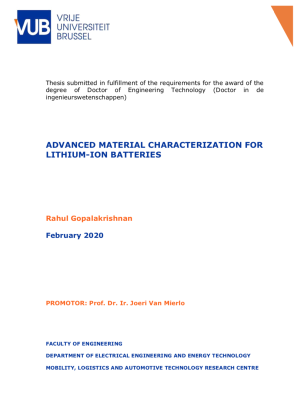
This doctoral dissertation aims for the study of lithium-ion batteries, in particular for the Nickel Manganese Cobalt Oxide (NMC)/graphite-based battery chemistry, by means of electrochemical characterization and analytical techniques. In this work, NMC batteries are studied at electrode level as well as in pouch cell level.
Pouch cells containing NMC/graphite electrodes (commercial cell from EIG and prototype cell from Leclanche) are characterized thorough EIS at different temperatures to assess the behaviour of the cells due to variations in seperator, electrolyte used and the cell design.
Electrochemical characterizations of electrodes are conducted by means of: Equilibrium Potential test, Galvanostatic Intermittent Titration Technique (GITT), Electrochemical Impedance Spectroscopy (EIS), Scanning Electron Microscopy (SEM), and X-ray diffraction (XRD). The sensitivity of the seperators (polymer and ceramic) and electrolytes used in combination with NMC 442, 622 and 622 (modified surface morphology) cathodes is observed and reported.
Ageing characterization of commercial EIG pouch cells are also conducted through EIS to gain insights on the degradation processes within the cells. The effect of relaxation time and the effect of cycling rates in combination with temperature is also studied.
This work was performed in combination with modelling researchers to provide inputs for their models. The accuracy of the model is determined based on the characterization procedure. Hence, this work not only characterizes electrode materials from different suppliers but also provides a procedure in which they should be tested to extract parameters for electrochemical and ageing models.
